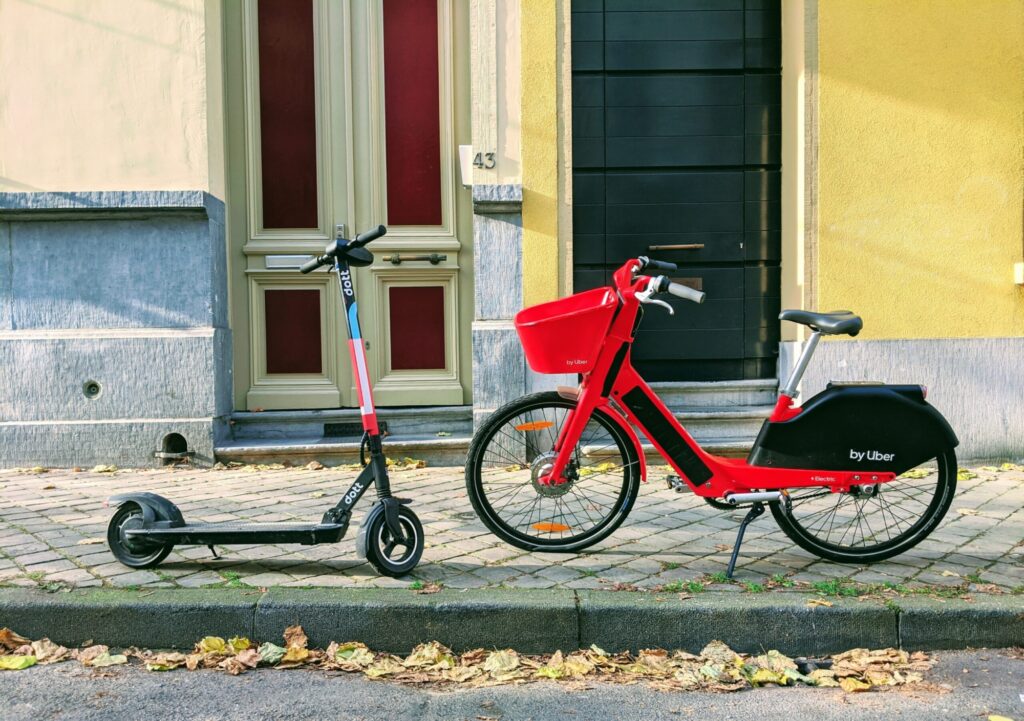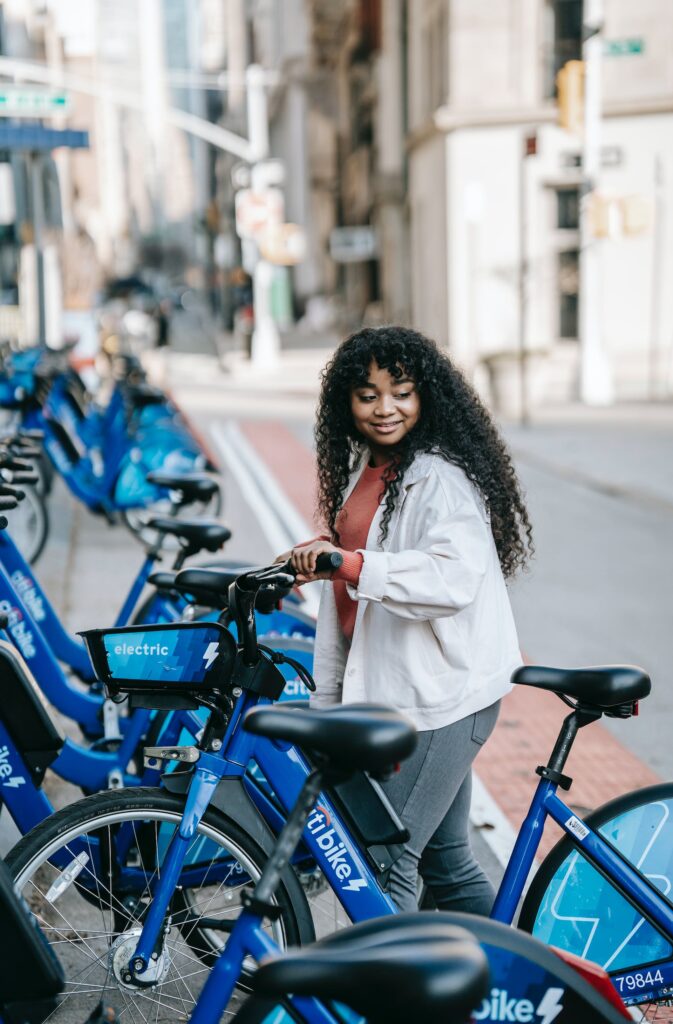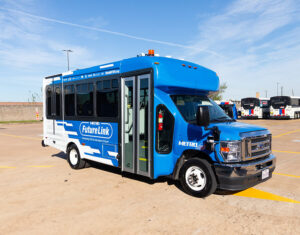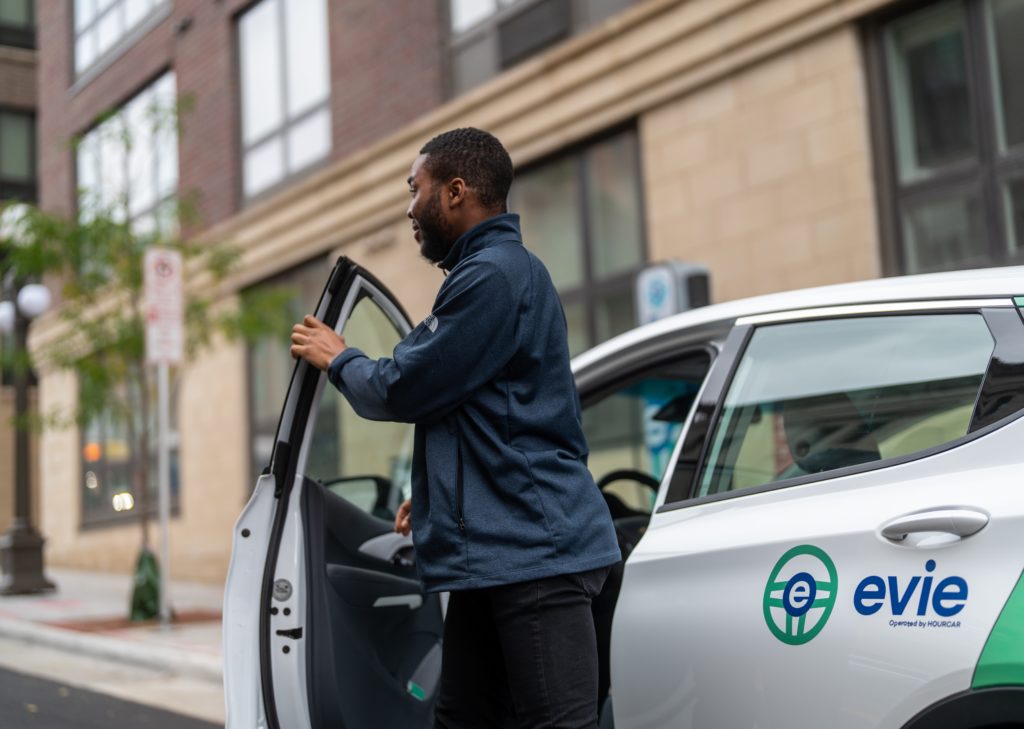A Review of Shared Mobility in 2023
20 minutes Date Launched/Enacted: Jan 12, 2024 Date Published: January 16, 2024

Through research, provision of technical expertise to cities and agencies across the region, peer-to-peer convening, and development of tools and other resources, the Shared-Use Mobility Center (SUMC) tracks trends happening throughout the shared mobility industry. Within the past year, we’ve seen various pieces of the shared mobility space shift and evolve. Innovations in technology and partnerships, context-sensitive thinking, an increased interest in equity, growing enthusiasm for public transportation, and the diversification of modes that shared mobility brings to cities have prompted changes to cities, agencies, and organizations’ approaches to shared mobility. Many of the resources noted below are available through SUMC’s Mobility Learning Center, an online resource curating and evaluating transportation industry developments.
Overall, we’re seeing shared mobility further integrate itself into daily life. Microtransit and micromobility pilots are paving the way for people to view transportation as more than just a means to get to work. Cities and agencies are experimenting with microtransit to facilitate first and last-mile connections and supplement existing transit services. Community-driven bikeshare initiatives have taken off, and individuals are increasingly using micromobility for shorter trips to the grocery store, social activities, and more. Even state Departments of Transportation are engaging in shared mobility initiatives and research. Below are some key takeaways from the past year.
Micromobility is a growing, but volatile industry

Credit: Uriel Mont on Pexels
For micromobility, 2023 saw both highs and lows. According to NABSA’s most recent State of the Industry report, micromobility ridership is back to pre-pandemic levels, and new bikeshare and scootershare systems are more available in more cities than ever before. NACTO’s September 2023 report on shared micromobility in the U.S. and Canada also shows immense growth in the industry, and notes that there were over 130 million trips on shared e-bikes and e-scooters in the U.S. and Canada in 2022.
However, while micromobility ridership continues to grow in many places, the underlying landscape is still extremely unpredictable, especially for private operators. In March, Nice Ride in Minneapolis, MN shut down after Lyft’s sponsorship contract with Blue Cross and Blue Shield of Minnesota ended in 2022, leaving the city without a bikeshare system for the first time in more than a decade. Houston, TX’s bikeshare also abruptly shut down in September 2023 after Houston BCycle, a non-profit operator, could not keep up with rising operational costs. However, Houston METRO later announced plans for its own bikeshare program. Once the new bikeshare system launches in 2024, it will be one of a very small number of systems owned and operated by a transit agency, hopefully opening the door for seamless fare integration and better first and last mile connections. Research shows that successful shared micromobility systems often involve municipal ownership or management. Thus, partnership models where local governments or transit agencies play a larger role in micromobility programs may see more fruitful outcomes.
Despite a somewhat volatile landscape, many cities and states are exploring ways to encourage micromobility use, both shared and private. There are a variety of incentive programs in the U.S. for people purchasing e-bikes, and 2023 saw even more cities and states offer rebates or vouchers for electric micromobility, including Columbus, OH, Pasadena, CA, Bend, OR, Connecticut, and Colorado.
Community-driven bikeshare initiatives are gaining popularity
As mentioned previously, bikeshare is available in more places than ever before, and many of these systems began as grass-roots initiatives. Several new community-oriented bikeshare systems emerged in 2023. For example, in Youngstown, OH, YoGo Bikeshare, a small, family-owned business launched in March with a fleet of 30 e-bikes and four docking stations. In another more rural part of the state, Sandusky County Public Health partnered with the YMCA of Sandusky County to launch a free bike library for the community.
Supported by the Clean Mobility Options (CMO) program, Shasta Living Streets officially opened a bike depot in downtown Redding, CA, in May 2023. The depot, located near Redding’s downtown transit center, is a community space which hosts various biking amenities, youth programs, e-bike charging, and stations for Redding Bikeshare, the city’s e-bike sharing system which also launched earlier in 2023. Along with CALSTART, as a co-administer of the CMO program, SUMC is in a unique position to learn from these community-based, equity-focused shared mobility pilots as we provide technical assistance to understand the planning and implementation considerations – lessons we intend to share as the pilots continue to mature.
To support bikeshare, the Santa Barbara Public Library began offering free weekly passes to the city’s bikeshare system, Santa Barbara BCycle, at no cost to library card holders. On the topic of libraries, the Colonial Heights Library in Sacramento, CA is also supporting shared micromobility by allowing cardholders to rent e-tricycles. In fact, several library systems have piloted bicycle rental programs as part of their services, a trend which is followed by community organizations across the country that have started bike or e-bike libraries. Examples like these show that communities are working on creative solutions to improve mobility through active transportation and integrate mobility options with other essential services.
Cities and transit agencies are embracing new technologies - and refining old ones
Around the country, mobility leaders are exploring how new technologies can be leveraged to improve access, agency operations, and rider experience. There are many examples of agencies embracing technological advancements from 2023, but below are a few that stuck out to us.
A major technological advancement that grew in 2023 is automation. Autonomous vehicles (AVs) are still relatively new to the shared mobility space, but several transit agencies are integrating these technologies into their fleets to better understand how their presence and functionalities contribute to the sustainability and advancement of transit systems. In December 2023, Houston METRO became the latest agency to introduce AV technology to the public when the agency unveiled its new AV shuttle. The shuttle, FutureLink, is a fully autonomous, zero-emission vehicle, which will transport riders between Texas Southern University and Houston METRO’s Eastwood Transit Center.
Another trend that grew in 2023 is data interoperability in mobility services. While data interoperability is not a new concept, there has been an increasing awareness of the role that open-data solutions can play in the discovery and coordination of transportation and related services. Data standardization helps with communication across multiple modes, services, and mobility providers, and can assist with coordinating complete trips. Interoperable systems and data standardization are essential to improve public transportation and shared mobility systems and make them accessible for all. When systems are interoperable through open-data solutions, it allows trip information to be shared between service providers, making transportation more seamless, efficient, and functional for riders. Early in 2023, the Minnesota Department of Transportation (MnDOT), with support from an Accelerating Innovative Mobility grant from the Federal Transit Administration, launched a multimodal trip planner in southern and western Minnesota, which allows riders to search through various mobility options and directly book and pay for some of those services using a smartphone app. MnDOT’s regional MaaS pilot stands apart from others as it incorporates two emerging data specifications, GTFS-Flex and the Transactional Data Specification (TDS). GTFS-Flex allows for the discovery of flexible or demand-responsive transportation, and the TDS is a backend data specification that facilitates communication across service providers and scheduling agents. For more on MnDOT’s pilot project, read SUMC’s case study here and for more information on data specification, see SUMC’s case study, “The Role of Data Specifications in Creating an Interoperable Transportation System.” Interoperable systems can transform shared mobility, and 2023 saw large strides in the development of this technology.

Credit: Houston METRO
Other advancements this past year include the General Transit Feed Specification (GTFS) inclusion in the National Transit Database (NTD), opening the doors for many rural and small-town transit agencies to experience the benefits of GTFS, and the discovery of fixed-route transit service. National RTAP has a number of online resources, including a GTFS Builder, to help small transit agencies develop their GTFS data feeds. Other developments include the release of the open-data procurement guide from Mobility Data Interoperability Principles. And earlier this year, SUMC released a case study outlining The Path to Mobility Interoperability. More work is still needed on this front, but the industry is moving forward in learning how to further incorporate open-data solutions to improve public transit services.
Participatory data and crowdsourcing are enhancing universal mobility
Universal Mobility is a design practice that ensures that all transportation products and services are inclusively designed and available for all user groups. This approach is increasingly becoming more common and vital as the discoverability and accessibility of shared mobility options and supporting infrastructure can be major challenges to completing trips and fulfilling daily tasks. SUMC released a learning module in July 2023 on Universal Mobility in coordination with the National Center for Mobility Management (NCMM). The module explores many universal mobility initiatives, including how open-data solutions promote universal mobility and accessibility of transportation services.
Having a place to share and access real-time mobility data helps address transportation issues related to the discoverability of services, accessibility of those services, and management of supporting infrastructure. Participatory data collection and crowdsourcing are becoming powerful tools to address these challenges and support complete trip initiatives. These platforms provide a dynamic way to gather and utilize data that directly impacts transportation network design and individual travel behavior.
There are a few initiatives working on crowdsourcing sidewalk and accessibility solutions that have gained traction in 2023. Project Sidewalk, a web-based crowdsourcing platform where users can label in-accessible sidewalks in some North American cities, offers an example of standardizing this approach. Overseen by the Makeability Lab at the University of Washington and other project partners. Another crowdsourcing sidewalk platform is Open Sidewalks, overseen by the Taskar Center for Accessibility Technology, also based out of the University of Washington. Both programs are testing standardized crowdsourcing solutions to record sidewalk availability and condition – critical pieces to accommodating a complete trip. If a person cannot access a bus stop or rail station due to sidewalk issues, then the transportation system as a whole is not accessible.
Similarly, BiciZen is a collaborative platform that aims to create a more seamless trip journey for those who bike by allowing users to report and access street-level information on bike lane obstructions, theft incidents, bike parking availability, and infrastructure or safety concerns. By collecting and disseminating detailed information about biking conditions, obstacles, and facilities, cyclists can plan their trips more effectively. Furthermore, this user-generated information can contribute to broader research efforts to ensure universally accessible and inclusively designed mobility networks as it may be used to inform better bike infrastructure and policy.
Ultimately, whether used to supplement transit or active transportation travel, crowdsourced platforms that share current accessibility or trip barriers showcase an increased interest in helping people move around cities with more ease. Project Sidewalk, Open Sidewalks, and BiciZen signify the growing popularity of community-driven solutions to facilitate complete trips and create more universally accessible transportation.
Elevated focus on equity and public transit incentives is shifting fare policy
Many transit agencies are leveraging fare policy to influence ridership and promote more equitable transit systems. Fare capping, zero-fare measures, mobility wallet programs, and universal basic mobility efforts showcase that agencies are thinking proactively about how to address challenges that riders and agencies both face.

Credit: Samson Katt on Pexels
Fare capping is a way to ease the financial burden of riding public transit for customers who sometimes cannot afford or cannot rationalize paying for an entire transit pass at once. In 2023, fare-capping policies became more popular at agencies around the country as a way to promote equity and attract riders. In July, LA Metro in Los Angeles, CA implemented a new fare payment policy that caps the number of single-ride fares at $5 per day and $18 per week when using a TAP card. Cherriots in Salem, OR also launched an account-based fare payment system which will allow the agency to implement fare capping.
Mobility wallets have also emerged as an effective method to alleviate financial strain for public transportation users among larger agencies. The mobility wallet concept aims to streamline the process of paying for mobility services by enabling riders to use a single platform for payment, addressing potential financial barriers to travel so that riders can more easily access different public transportation options. It also allows users to have a backup option when certain types of public transportation can’t meet their trip needs.
For instance, LA Metro recently teamed up with LADOT to launch their mobility wallet pilot program, which provides community members in South L.A. $150 per month via a prepaid debit card to use on shared mobility transportation, such as Metro rail, bus, BlueLA EV car share, Amtrak, and bikeshare. Participants can also use the transportation funds to pay for services in bicycle shops, further expanding mobility options. Other cities are following suit; the City of Seattle is assessing the possibility of piloting their own mobility wallet program to diversify trip journeys and increase access to transportation.
Other equity-based payment initiatives like zero-fare transit, are still seeing new and positive impacts. Following a nearly two year long pilot program, Albuquerque City Council made its zero-fare pilot program permanent on ABQ RIDE services. Rhode Island Public Transit Authority (RIPTA), which is experimenting with innovative technologies to inform new fare policies, extended its Ride Free Central Falls Program, which uses geofencing technology in the Wave Smart Ticketing System to enable one-way free transit rides for individuals who board within the City of Central Falls’ boundary.
Meanwhile, the Southeastern Pennsylvania Transportation Authority (SEPTA) rolled out various fare-centered pilot programs this past year, including a Zero Fare Pilot Program that offers 25,0000 low-income eligible Philadelphia residents free SEPTA rides and a Contactless Fare Payment Pilot giving riders the ability to pay for transit via a credit card or mobile wallet. SEPTA also expanded their Key Advantage Program allowing all Philadelphia employers to opt-into offering their employees discounted transit passes in hopes of boosting overall system ridership.
These initiatives taken up by transit agencies across the county demonstrate a renowned focus on how payments shape equitable and user-first public transportation, underlying the importance that fare policy plays in shaping the future of mobility.
Microtransit is expanding its presence and role
In 2023, the number of cities and rural areas piloting or permanently establishing microtransit programs continued to expand across the country. Charlottesville Area Transit (CAT) launched MicroCAT, a microtransit service offering curb-to-curb rides in the Pantops and Route 29 North areas near Charlottesville in an attempt to serve the lower-density areas of Albemarle County. Calexico On Demand, a microtransit service designed to increase access for low-income residents, seniors, and youth, rolled out in Calexico, California, a border town historically challenged by a lack of public transit options and poor air quality. For the City of Calexico, microtransit represents the chance to fill mobility gaps left by the absence of a fixed-route intracity transit system.
Despite valid concerns over microtransit’s limitations in productivity and expense per rider in relation to regular bus service, these services continue to bring reliable transportation options for those in sparsely populated or underserved areas.
With that said, microtransit is beginning to find its place as a supplemental tool to fixed routes and other transit services rather than a replacement. This past year, we’ve seen different cities and agencies leveraging microtransit to support first and last-mile connections, serve workforce hubs, and provide after-hours transportation. Pace, Chicagoland’s suburban bus and regional paratransit provider, launched a late-night microtransit service called Pace Connect designed to provide first and last-mile connections during late-night hours. It has two service zones: the area surrounding Chicago O’Hare International Airport and the area surrounding the town of Harvey, a low-income community south of Chicago, which contains various employment hubs, offering riders a way to get to and from work in a safe, affordable way.
Similarly, the Greater Cleveland Regional Transit Authority (GCRTA) launched Connectworks, a microtransit pilot that brings people from bus stops to employment opportunities in two locations in the Cleveland area, eliminating the need for lengthy walks between RTA transit centers, bus stops, and job sites. The program offers employees rides to and from the Southgate Transit Center and BrookPark Station, connecting them with their workplaces in Solon and the Aerozone Alliance Region respectively.
For more information on innovative microtransit, see some of SUMC’s 2023 case studies on The Wilson Ride, MATA Ready!, and DART Connect.
State Departments of Transportation are investing in shared mobility
In the last year, there has been notable interest and investment from state DOTs in the role shared mobility can play in addressing gaps in transportation networks.
The Missouri Department of Transportation released an RFP to gain insight into how other state departments of transportation and metropolitan planning organizations can use innovative mobility solutions such as microtransit to support first and last-mile mobility connections for their workforces.
Connecticut Department of Transportation announced the launch of their statewide microtransit program that will dedicate $20 million in funding to nine transit districts and municipalities in Connecticut to develop their own microtransit pilots. This 2-year program aims to close gaps in Connecticut’s extensive public transportation network by offering new mobility options in areas unserved and underserved by public transportation.
New York Department of Transportation expanded its citywide curbside on-street carsharing program after a successful five year pilot. To kick off the expansion, 80 new, dedicated curbside parking spaces were installed for carshare service across Brooklyn, the Bronx and Queens; however the expansion will ultimately see new carshare spaces brought to all five boroughs.
Carshare can be a valuable part of communities’ transportation networks
As carsharing is experiencing new growth on a national level, mobility organizations and agencies are exploring ways to integrate carshare services with public transit systems. Evie, the nation’s first 100% renewably powered and municipally owned car-share service located in the Twin Cities, continues to grow among users, recording its 150,000th trip in 2023 and seeing a record-setting 14,000 trips in October. As Evie’s success persists, the program plans to make cars available at the new stations along the Gold Line bus rapid transit that will kickoff in 2025.

Credit: Evie
In a similar vein, integration of carshare and public transit is echoed in Canada’s Greater Golden Horseshoe region. Earlier this summer, Go Transit, the regional public transit service for this area, established a partnership with peer-to-peer carsharing company Turo. The partnership offers riders the ability to request vehicle delivery at Go Stations, extending trips beyond Go’s transit system and strengthening mobility connections within Ontario’s transportation network.
Conclusion
Last year was pivotal for shared mobility. As the industry continues to recover nearly four years after the beginning of the COVID-19 pandemic, leaders are still working to understand how peoples’ travel habits have evolved and how to make sure transportation systems work best for everyone. The year was not without its challenges, and the shuttering of some micromobility systems serves as an example of how important it is to invest in shared modes. However, 2023 also brought many innovations, as transit agencies, cities, and mobility leaders continue to explore new technologies and processes to encourage equitable, sustainable, safe, and shared transportation. Overall, 2023 was a promising year for shared mobility, and we look forward to seeing how the industry advances in 2024.